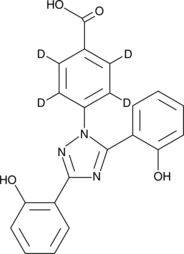Territorial Availability: Available through Bertin Technologies only in France
- Synonyms
- 4-[3,5-bis(2-hydroxyphenyl)-1H-1,2,4-triazol-1-yl]-benzoic-2,3,5,6-d4 acid
- Correlated keywords
- ICL670A ICL-670A ICL670-A ICL-670-A deuterated deuterium GCMS LCMS D-1 NMyc NDRG-1 3 BxPC-3 Copper Zinc Magnesium Calcium Aluminum
- Product Overview:
Deferasirox-d4 is intended for use as an internal standard for the quantification of deferasirox (Item No. 16753) by GC- or LC-MS. Deferasirox is a synthetic, tridentate iron chelator that binds iron at a 2:1 ratio.{36858} It is selective for iron (Fe(III)) over Cu(II), Zn(II), Mg(II), and Ca(II) but does bind to Al(III). Deferasirox decreases iron levels in iron-loaded rat heart cells in vitro by 45.8 and 55.6% compared to control levels when used at concentrations of 160 and 320 µM, respectively.{27434} In hypertransfused rats, deferasirox (200 mg/kg) decreases radiolabeled liver iron levels from 41 to 21.7% and blood iron levels from 8.2 to 3.4%.{27434} It is primarily excreted via the fecal route, in contrast to the iron chelator deferoxamine (Item No. 14595).{27434} Deferasirox also inhibits proliferation of SAS human oral squamous carcinoma cells (EC50 = 21 µM), decreases cyclin D1 protein levels, and increases protein levels of N-Myc downregulated gene 1 (NDRG1) and NDRG3.{38960} It acts in a synergistic manner when used in combination with gemcitabine (Item Nos. 11690 | 9003096) to reduce proliferation of BxPC-3 pancreatic cancer cells in vitro and reduce tumor growth in a BxPC-3 mouse xenograft model when administered at a dose of 200 mg/kg.{36859} Formulations containing deferasirox have been used in the treatment of ?-thalassemia and chronic iron overload.
Cayman Chemical’s mission is to help make research possible by supplying scientists worldwide with the basic research tools necessary for advancing human and animal health. Our utmost commitment to healthcare researchers is to offer the highest quality products with an affordable pricing policy.
Our scientists are experts in the synthesis, purification, and characterization of biochemicals ranging from small drug-like heterocycles to complex biolipids, fatty acids, and many others. We are also highly skilled in all aspects of assay and antibody development, protein expression, crystallization, and structure determination.
Over the past thirty years, Cayman developed a deep knowledge base in lipid biochemistry, including research involving the arachidonic acid cascade, inositol phosphates, and cannabinoids. This knowledge enabled the production of reagents of exceptional quality for cancer, oxidative injury, epigenetics, neuroscience, inflammation, metabolism, and many additional lines of research.
Our organic and analytical chemists specialize in the rapid development of manufacturing processes and analytical methods to carry out clinical and commercial GMP-API production. Pre-clinical drug discovery efforts are currently underway in the areas of bone restoration and repair, muscular dystrophy, oncology, and inflammation. A separate group of Ph.D.-level scientists are dedicated to offering Hit-to-Lead Discovery and Profiling Services for epigenetic targets. Our knowledgeable chemists can be contracted to perform complete sample analysis for analytes measured by the majority of our assays. We also offer a wide range of analytical services using LC-MS/MS, HPLC, GC, and many other techniques.
Accreditations
ISO/IEC 17025:2005
ISO Guide 34:2009
Cayman is a leader in the field of emerging drugs of abuse, providing high-purity Schedule I-V Controlled Substances to federally-licensed laboratories and qualified academic research institutions for forensic analyses. We are certified by ACLASS Accreditation Services with dual accreditation to ISO/IEC 17025:2005 and ISO Guide 34:2009.





